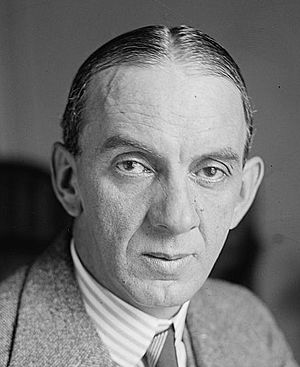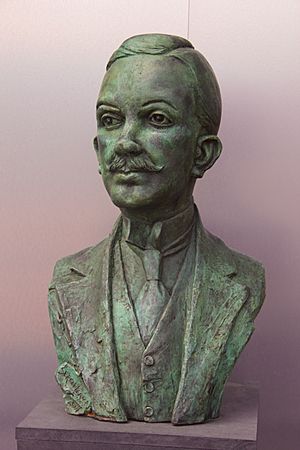Manuel Gamio facts for kids
Manuel Gamio (born in 1883, died in 1960) was an important Mexican anthropologist. He also worked as an archaeologist and sociologist. Gamio was a key figure in the indigenismo movement in Mexico. This movement aimed to help and integrate Mexico's native communities.
Even though he didn't think indigenous groups should be fully independent, he believed their own ways of governing should be respected. This included their tribal governments and elected leaders. Many people see him as the founder of modern studies about people and cultures in Mexico. He also created a way to classify hunter-gatherer groups in Central America.
Learning and Early Life
Gamio was born in Mexico City. He first studied engineering there at the School of Mining. Later, he focused on archaeology and anthropology. He learned from experts like Nicolás León and Jesús Galindo y Villa. This was at the International School of American Archaeology and Ethnology.
When he was 19, he paused his studies. He went to work on his family's rubber plantation. This plantation was located where the states of Oaxaca, Veracruz, and Puebla meet. There, he learned the Nahuatl language from the workers. This experience sparked his deep interest in Mexico's native cultures.
He later returned to study at the National Museum. His teacher, Zélia Nuttall, sent him to Columbia University in 1909. There, he studied with Franz Boas and earned his Ph.D. Boas was a famous anthropologist. Gamio learned a lot from him, especially how to study cultures. Boas even considered Gamio one of his best students.
Work in Mexico and Guatemala
Gamio came back to Mexico in 1910. The next year, he helped start the International School of Archaeology and Ethnology of the Americas. This school was in Mexico City. It received money from Germany and the United States. Other famous scholars like Eduard Seler and Franz Boas were also involved.
This was during the Mexican Revolution, a difficult time for the country. Despite this, they managed to open the school. Gamio led the school from 1916 to 1920. It eventually closed because it ran out of money.
In 1911, Gamio created a timeline for pottery in the Valley of Mexico. He based this on earlier digs in Azcapotzalco. From 1913 to 1916, he was a main inspector for archaeological sites. He worked for the Mexican Ministry of Public Education. He did fieldwork in many places. These included Copilco, Cuicuilco, and the Templo Mayor in Mexico City. He also worked in Zacatecas, Yucatán, Ecuador, and Miraflores in Guatemala.
Gamio was the first scientist to explore the ancient city of Teotihuacan. His research led to his book La población del valle de Teotihuacan (The Population of the Valley of Teotihuacan). This book was published in 1922. It was an updated version of his Ph.D. paper. This work is still very important for learning about the people of the northern State of Mexico. He also made some documentary films. He thought Teotihuacan might have had as many as 300,000 people.
In 1916, he published another important book, Forjando patria: pro nacionalismo (Forging a Fatherland). This book discussed how to help native Mexicans join the larger Mexican society. Other books he wrote in Spanish include Hacia un México nuevo (1935) and Consideraciones sobre el problema del indigenismo (1948).
In the 1920s, he studied the highlands of Guatemala. He focused on pottery styles near cities like Quiche and Quetzaltenango. He noticed that pottery from Guatemala was similar to pottery from central Mexico. Because of this, Gamio believed that Mayan civilization might have started in central Mexico. He thought some early people from central Mexico moved away. They were looking for a place safe from earthquakes and volcanoes.
Gamio's writings about Mexico's native people were very important. They helped show the ancient Anahuac as a glorious part of Mexican history. Gamio, like President Lázaro Cárdenas in the 1930s, worked to help native people become part of Mexico's national life.
Work in the United States
In 1925, Gamio moved to the United States. He left Mexico after speaking out against corruption in the Ministry of Education. In the U.S., he focused on Mexicans moving and working there. He did this research for the Social Science Research Council in Washington, D.C.
Gamio published two books about this research in English. They were Mexican Immigration to the United States (1930) and The Mexican Immigrant: His Life Story (1931). These books have only recently been translated into Spanish. This allows modern Mexican anthropologists to use them.
He returned to Mexico in 1930. There, he held several government jobs. He also continued his studies of people and cultures. From 1942 until his death in 1960, he led the Inter-American Indian Institute.
See also
 In Spanish: Manuel Gamio para niños
In Spanish: Manuel Gamio para niños



